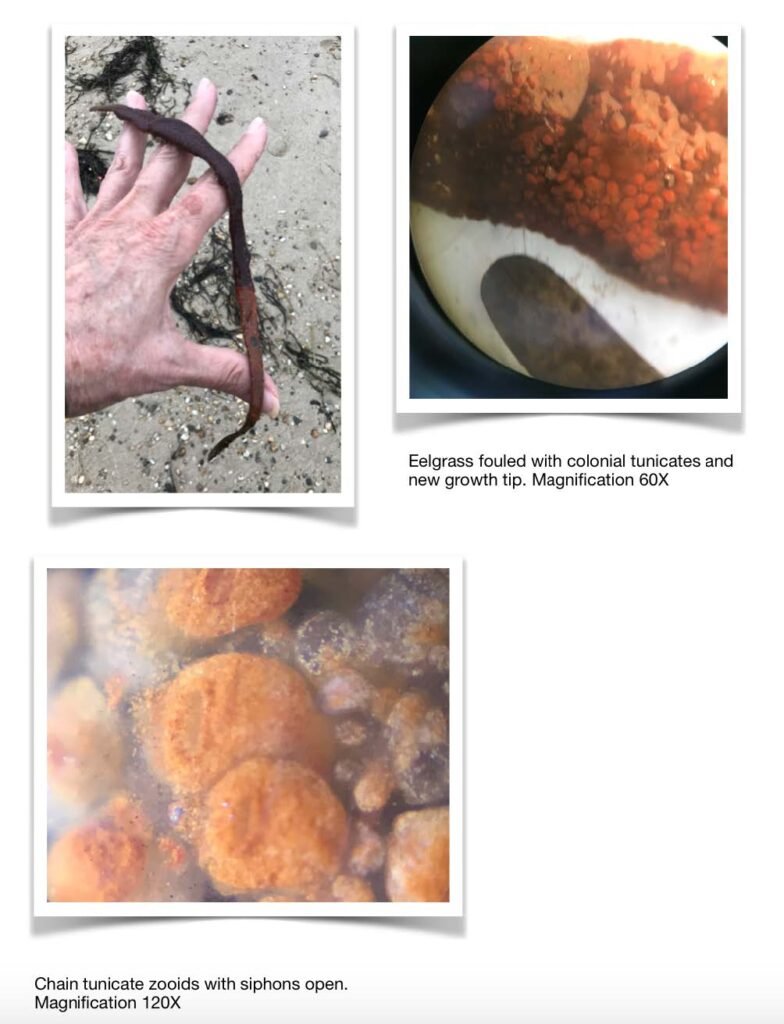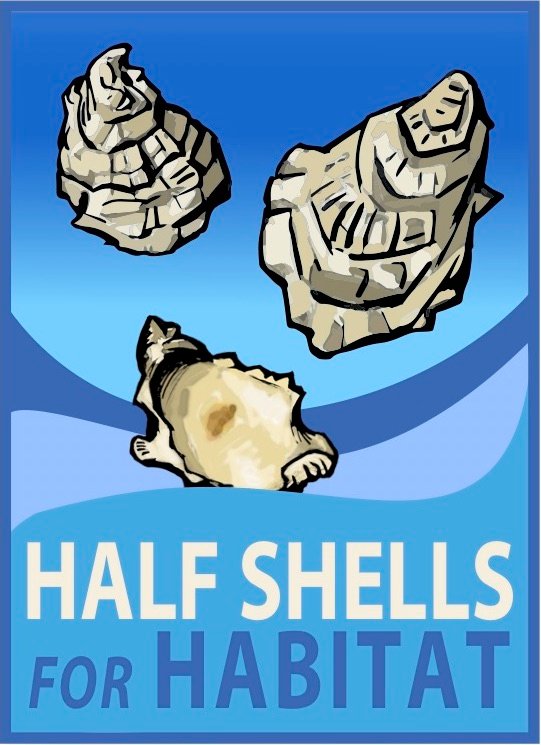I found a strange creature in the waters of the Great South Bay along the south shore of Long Island. It looked like giant worm floating on the sea surface. I had observed something similar a few days earlier, entwined in a mass of floating eelgrass. The creature was about 3/4 inch wide, and about 10 inches long with a firm rubbery texture. It was mostly burgundy with ridges on the upper surface (See Figure 1). I picked it up and examined it closely with a magnifying glass. Upon closer inspection, I realized this was not a worm at all — it is an organism called a colonial tunicate.
Most people are unfamiliar with tunicates so let me provide you with some background. Tunicates are commonly known as “sea-squirts.” They always possess a firm jelly-like coating or tunic and spend all of their adult lives firmly attached to an underwater surface. They belong to the taxonomic class Ascidiacea, so scientists refer to them as Ascidians. Although they seem alien, scientist have also discovered that tunicates are in fact more closely related to humans than any invertebrate. You see, for a short time after they hatch, larval tunicates resemble little swimming tadpoles and at that time in their life they possess a primitive backbone. This feature places tunicates in the same larger taxonomic phyla, Chordata, as humans. Once attached to a substrate (docks, gear, eelgrass) they metamorphose into their adult form, living the rest of their life in one place.
Tunicates come in two types, solitary and colonial. The solitary tunicates, usually about the size of a grape or apricot, can be found on rocks, pilings, boats, and docks. If you touch them they squirt water. In contrast, the creature I found floating in the water was a colonial tunicate. A colonial tunicate is composed of thousands of tiny tunicates fused together as one living organism. Colonial tunicates can reproduce using three different methods: budding, fragmentation, or releasing swimming larvae, so they easily disperse and are able to quickly grow in numbers until they completely cover the surface of the object to which they have attached.
Colonial tunicates often appear as amorphous blobs coating any surface that allows them access to flowing water. Under a magnifying glass, the mass of minute organisms can be seen sucking in water through their individual siphon-mouths (See Figure 2.) . In this way, they filter microscopic particles out of the seawater to consume as food. A primitive gut digests the filtered food and a shared anus-siphon expels waste. Blood vessels connect each individual, called a zooid, together allowing the colonial tunicate to function as a single unit.
The colonial tunicate I observed had settled on, and then grew all over, a long, thin blade of eelgrass, giving it the appearance of a large worm. The growing tip of the eelgrass blade remained uncovered because it grew faster than the tunicate could reproduce. (See Photo 3.). Underwater waves most likely released the tunicate-covered eelgrass blade much like the wind blows a leaf off a tree. The broken eelgrass blade coated in colonial tunicates, when freed from the plant roots, floats on the water’s surface.
In an effort to identify exactly what species of colonial tunicate I had observed, I searched the scientific journals and found that at least four types of colonial tunicates have been reported to grow on eelgrass around Long Island (Carman et al. 2019). They are: Botryllus schlosseri; Botrylloides violaceus; Didemnum albidum (rare and native colonial); and Diplosoma listerianum. Three of these are non-native and two of those are considered invasive.
Originally from Asia and Europe, they have few predators here on the East Coast. At one study site in Moriches Bay, Long Island, colonial tunicates were observed to cover 25 to 50% of the eelgrass blades (Carman et al. 2019). Unfortunately, the type I found coating the eelgrass blades appears to be the non-native and highly invasive, chain tunicate (Botryloides violaceus), sometimes known as the violet tunicate. It is found globally, including the east coast of North American from New Jersey to Prince Edward Island, Canada. Scientists think the colonial, chain tunicates may be increasing in numbers in the waters around Long Island, but there is not enough evidence to be sure. They do know that here, in the warm, nitrogen-polluted waters of the Great South Bay, chain tunicates can find an abundance of food. Microscopic bacteria and algal blooms fueled by high levels of nitrogen in the seawater support the accelerated growth of non-native colonial tunicates.
The invasive, colonial chain tunicates can grow on any surface that provides them with access to flowing seawater. However, they are especially fond of attaching to eelgrass blades. Eelgrass is unusual in that it is not an alga or green seaweed. It is actually a type of aquatic grass that, unlike seaweed, is considered a “higher plant,” possessing stems, roots, and leaves. The roots hold the plant in place on the bay bottom while the long, thin blade-shaped leaves sway in the tidal currents. Eelgrass uses sunlight to make its energy.
However, when smothered in living tunicates, the plant can not get enough sunlight and it dies. This is especially devastating for the estuarine environment and associated wildlife because eelgrass is considered a foundational species, providing critical food and habitat for many types of wildlife, especially ducks, bay scallops, crabs, and small fish. It is also known to stabilize sediments, thereby inhibiting coastal erosion. Eelgrass beds serve as nurseries for juveniles of many important fish species and when healthy, they oxygenate water and provide a refuge where marine wildlife can escape the harmful effects of coastal ocean acidification. 
In addition to harming eelgrass, invasive colonial tunicates have also been known to directly kill scallops and larval oysters and to smother natural oyster reefs. They may be capable of preventing larval oysters from attaching to the reefs, although the exact mechanism is not known. In general, they out-compete native organisms, reduce biodiversity and alter the ecosystem in areas they inhabit. There is still a lot we don’t know about these fascinating creatures.
With the potential to be destructive, invasive colonial tunicates are a growing concern for natural resource managers, ecologists, and shellfish growers. Worldwide shipping increases the likelihood of invasion in coastal areas. These invasive species will colonize disturbed habitats and once they have invaded an area, it is considered impossible to get rid of them because they have few predators. So, the best approach for control is to limit their spread. Care should be taken not to spread fragments of the tunicate colony when removing these fouling creatures from fishing and aquaculture gear.
A recent New England Rapid Assessment Survey (Pederson et al., 2021) of non-native marine biofouling organisms conducted at three locations in New York (Brooklyn, Staten Island, and Greenport) revealed that chain tunicates are widespread and possibly increasing in the Northeast.
None of the sampling stations in that study were located along the south shore of Long Island and a lack of knowledge on this region remains. These Rapid Assessments are deigned to be repeated regularly; however, it has been 16 years since the previous assessment. It is important to know where these organisms are living, and due to their capacity to disrupt important ecological relationships, whether or not they pose an increasing threat. Regular assessment surveys are crucial for Long Island waters in the near future, especially in our south shore bays. Understanding invasive colonial tunicates will provide insight into the true health of our bays.
REFERENCES:
Carman M, Colarusso, P, Neckles H, Bologna P, Caines S, Davidson JDP, Evans N, Fox S, Grunden D, Hoffman S, Ma K. Matheson, K, Mckenzie C, Nelson E, Plaisted K, Reddington E, Schott S, Wong M (2019). Biogeographical patterns of tunicates utilizing eelgrass as substrate in the western North Atlantic between 39° and 47° north latitude (New Jersey to Newfoundland). 10. 602–616. 10.3391/mbi.2019.10.4.02.
Pederson J, Carlton JT, Bastidas C, David A, Grady S, Green-Gavrielidis L, Hobbs N-V, Kennedy C, Knack J, McCuller M, O’Brien B, Osborne K, Pankey S, Trott T (2021). 2019 Rapid Assessment Survey of marine bioinvasions of southern New England and New York, USA, with an overview of new records and range expansions. BioInvasions Records 10(2): 227–237, https://doi.org/10.3391/bir. 2021.10.2.01
